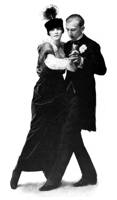
|
The Society of Folk Dance Historians (SFDH)
Allure of the Tango
[
Home |
About |
Encyclopedia | CLICK AN IMAGE TO ENLARGE |

|
 Tango! Perhaps no other dance has such a pull on those who choose to enter into its world. Many are the dancers who, having tasted the sweet ecstasy of tango, have never been seen again, having given their lives to its magical trance. Not a few ex-folk dancers can be found in the many milongas (an event where Argentine tango is danced) found throughout almost every large city.
Tango! Perhaps no other dance has such a pull on those who choose to enter into its world. Many are the dancers who, having tasted the sweet ecstasy of tango, have never been seen again, having given their lives to its magical trance. Not a few ex-folk dancers can be found in the many milongas (an event where Argentine tango is danced) found throughout almost every large city.
What gives the tango this allure, this exotic promise? Is it the charm of an intimate, sensual embrace with a perfect stranger? Perhaps the prelude to an even more intimate dalliance? Tango can be and has been many things to its admirers, even in all its many delightful versions and a study of tango's history would take volumes.
From the Spanish beginnings in old Andalusia as a dance for women, tango migrated to Spanish-held lands in South America, namely Argentina. By the late 19th century, it had become the property and practice of the Buenos Aires underworld, where unfettered by fashion and good taste, it began to display the earthy, uninhibited, and defiant world of the brothels. Lonely men, outcasts from proper society who frequented the outskirts of the city, sought to attract the sultry women who plied their trade and it became common practice for the men to practice and develop the tango among themselves to create a dance which the women could not resist.
 This all happened at a time when the closed dance position was still barely tolerated in polite society. The waltz and polka had achieved popular acceptance – more or less – in Europe and America, though not so much in isolated, conservative, and Catholic Argentina. But even there, the tango slowly made its way into the middle classes – with considerable "sterilizing" of the more suggestive movements of its origins.
This all happened at a time when the closed dance position was still barely tolerated in polite society. The waltz and polka had achieved popular acceptance – more or less – in Europe and America, though not so much in isolated, conservative, and Catholic Argentina. But even there, the tango slowly made its way into the middle classes – with considerable "sterilizing" of the more suggestive movements of its origins.
It did not take long for the tango to reverse its migration and return to the dance halls of Europe where each country seems to have had its way with it. The dance was colored with myths and mystery by those who stood to gain from its acceptance. It was said to be the dance of the colorful Argentine gaucho (it wasn't). It was said to be the dance of romance (it wasn't that, either). It was modified to meet the accepted standards of decency and decorum wherever it went: France, England, Italy, Spain – even Finland, where it remains in the social dance repertoire to this day.
The dance rarely resembled its earthy beginning. America first became aware of the dance with its introduction by Vernon and Irene Castle in their wildly successful six-year reign as America’s sweethearts in the fabled Ragtime dance era just prior to World War I. They lent the dance a playful, yet colorful style, uniquely different from any other and danceable by anyone with a little time to learn it. In truth, it was little different from the Fox Trot, but with more variety and character. Fred Astaire and Ginger Rogers depicted the dance in pseudo-Spanish / gaucho costumes, which did little to dispel the myths surrounding the dance.
Rudolph Valentino is said by modern tangueros to have caused more damage to the tango than anyone. Carrying the gaucho myth to the silver screen, Valentino gave Americans a glimpse of an almost-naughty, sensual dance, quite different from the Castles' version, but still far from the dance's origins. His portrayal of the tango became America’s idea of the dance.
Ballroom dancers took to the dance and gave it their own unique character, attempting to display the sensuous and challenging nature of the dance, but not quite daring to give up elegance to return to the tango’s underlying message. Only very recently have the International Ballroom Dancers begun to insert Argentine tango elements into their performances and competitions.
Back in Buenos Aires, the times were changing. Through lurid political changes and upheavals, the dance began to represent the true spirit of the Argentine culture – intense, passionate, angry, longing – "Latin." At last, the old dance found its place in the modern world. Enough time had passed that the sensuous promise of the tango was no longer vulgar and crude and despised. Women were free to express their own temperament and the tango was the perfect vehicle. With the tango, the music grew and became the voice of the people. Musicians received national hero status and singer Carlos Gardel is worshipped to this day as one of Argentina's greatest artists and patriots.
The production "Tango Argentina" hit the American public like a bombshell. Here was the real deal in all its sensuous, earthy splendor. No delicate, stylized, contrived gestures pretending to be sexy. This really was sexy – unabashed, unrestrained, and unashamed. America took to the Argentine tango as they had not taken to a dance in decades. Hundreds of new tangueros flocked to Buenos Aires in search of the "source" and returned to spread their knowledge of the dance to an ever-increasingly eager dance world, at great benefit to their – and Buenos Aires' – economies.
Milongas appeared everywhere – places where the tango is danced by dreamy-eyed aficionados of the true tango, locked together in close embrace, each partner sensing the full essence of the other. Legs intertwined in each other's space, beautiful legs boldly exposed to the hip in deep corté or wrapped seductively around the man's body; surely such uninhibited gestures say something about today's tolerance and outright acceptance of such bold display of self-image.
To the uninitiated, the technique of the tango is very mysterious. How do two people so closely entwined execute so complex and beautiful a dance. The basic concept appears to be that the man leads his partner around him as she executes a series of "grapevine" steps, crossing alternately in front and behind. The man then creates an obstruction for her, either with his own leg or by leading her in a change of direction. The woman then works her way around and over the obstruction, free to execute her own flourishes and embellishments. The styles of different couples vary greatly and many an observer sits transfixed by the beauty and fascination of this most alluring of dances.
DOCUMENTS
- Argentine Tango, an article.
- Richard Duree, an article.
- Tango Family Tree, an article.
- Waltz, One Step, and Tango Partnering Tips, an article.
Used with permission of the author.
This page © 2018 by Ron Houston.
Please do not copy any part of this page without including this copyright notice.
Please do not copy small portions out of context.
Please do not copy large portions without permission from Ron Houston.